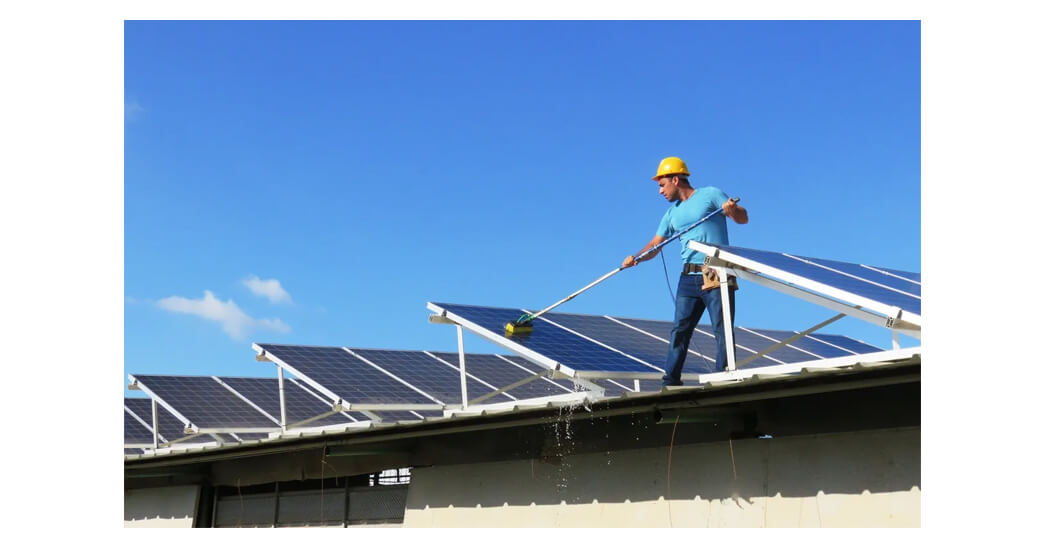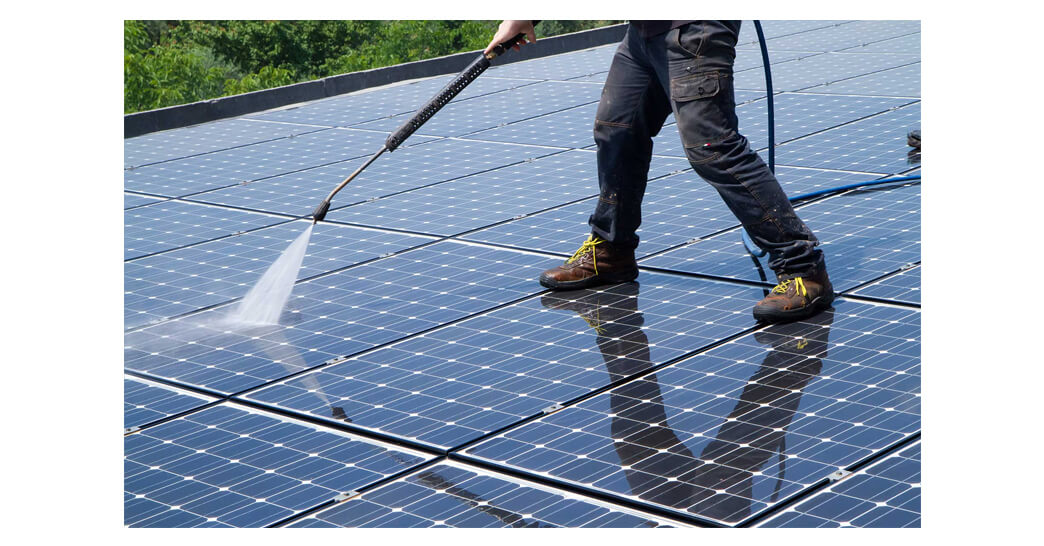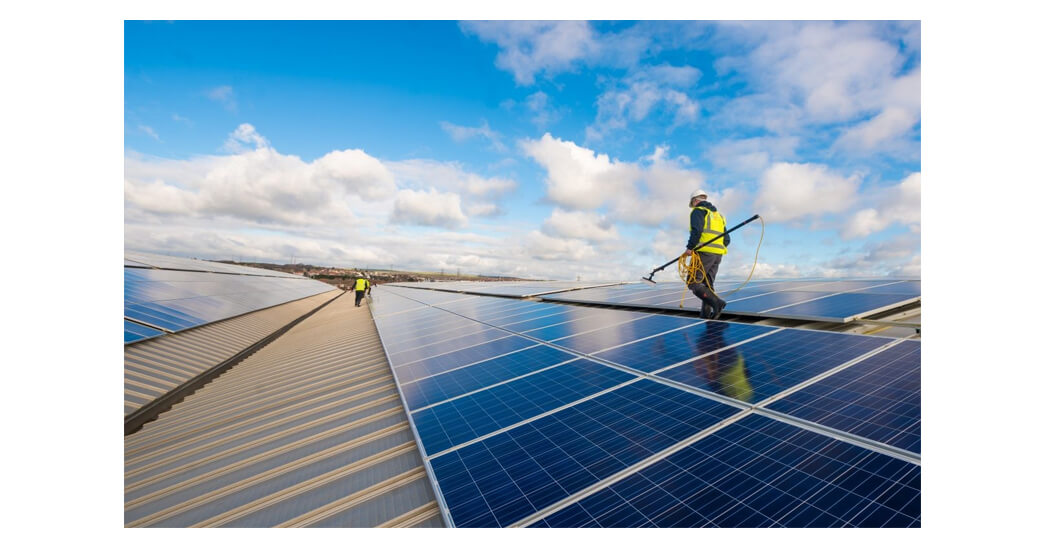Contents:
Australia enjoys a lot of sunshine and solar power has become one of its most common renewable energy sources. Millions of households are adopting solar panels to cut down on power costs and carbon pollution. This indicates that the solar panels should be kept free of dust dirt bird droppings or any other debris in order to get the maximum output. This will also give your pocket a break since minimal maintenance will keep your system functioning at maximum levels. This paper will make the best possible attempt to apprise you on the standard procedures for solar panel washing in Australia.

The Necessity of Solar Panel Cleaning
Australia has a variety of climatic regions including tropical in the north and arid in central and southern Australia. Assuming that such location does not exist, dust and mud have the terrible tendency of covering the surface of solar panels and reducing their efficiency. Without panels that are clean, around 20% efficiency loss can already be expected and that is why cleaning maintenance to the system becomes very critical.
In less rainy geographic areas such as central Australia, panels may collect more dust so much as to become ineffective while in coastal regions there are problems of salt accumulation. In urbanized locations, bird excrement can block illumination from reaching the photovoltaic cell thereby rendering it ineffective.
How Often Should You Be Cleaning Your Solar Panels?
The frequency of the cleaning of solar panels is determined by the user’s region and the environment. In Australia for instance, there are dust storms, pollen and salt spray among others therefore there has to be at least a bi-annual solar panel cleaning schedule. Nevertheless, if your area has a lot of debris, then cleaning more often – quarterly – is justified.
You must check out the energy output of the system. If there is a sharp decrease in the energy output then, the module might be dirty and a cleaning should be performed.

Applying Equipment in the Solar Panels’ Cleaning Task
To minimize the solar panel cleaning accident and maximize efficiency, some tools are necessary:
Solar panel cleaning brush: This is a specially designed brush, used for cleaning the surface of solar panels which is soft brush with application of many bristle to scratch the surface and dirt more effectively.
- A long-handled squeegee.
- A hose with a gentle spray nozzle.
- Non-abrasive sponges or microfiber cloths.
- Mild soap or detergent (optional).
These include metal brushes and pressure washing which should be avoided as they destroy the solar panels.
Step-by-Step Guide to Cleaning Solar Panels
1. No matter what the task, safety always comes first. For example, if your solar panels were put up on the roof, make sure to wear the proper protective/ safety equipment such as goggles or hard hats and do not attempt to clean them when it is raining or very windy. If you feel nervous about getting on the roof, have an expert do it.
2. Turn off the system before any maintenance of any kind can be done on your solar panel system, make sure that the solar panel is not active in order to minimize the risk of electrification. Electric parts must always be turned off according to manufactured instructions in the context of safety management.
3. Use Water to rinse the panels to begin with, rinsing the panels, a hose with low pressure is used to spray the panels removing the finer and movable dirt on it. Do not look for high speed of water as this may damage the panels. In australia, good time to clean the panel if its hot, is either first thing in the morning or in the late afternoon when the panels have cooled down and dried to avoid thermal shock which can cause the glass to break.
4. Clean the surface with a soft srush after rinsing your solar panels, carefully clean the surface with a solar panel cleaning brush with Soft Bristles. Extra caution is advised when scrubbing. In case more effort is necessary, a soap solution can always be employed to remove most soil bits; the solution should not contain any hazardous materials that might destroy the panel.
5. Wash the Panels Again After the panels have been properly scrubbed with soap, the purpose of this step is to rinse all dirt and grease that was present on the panels and any soap at the same time. It is important to avoid leaving streaks or marks due soap on the surface since these would filter the sunlight available.
6. Remove excess moisture from the Panels After rinsing, appropriate use of a long-handled squeegee and a microfiber cloth may be used to wipe the panels dry. This is not necessary however the step would serve to protect against water marks especially in hard water areas.

Maintaining Solar Panels in Australia
-
Watch for Performance: Its a good practice to monitor your panel system output using monitoring software. If there are changes, investigate the panels and try cleaning them if needed.
- Use Bird Deterrents: If bird activity is a concern be sure to install bird deterrents to avoid bird waste deposition on the panels.
- Cut Down Any Trees that May Shade the Panels: Ensure that trees or plants are not in a position to block your panels sunlight and do this more often especially in summer periods.
- Seek Professional Help: If you are not comfortable with cleaning the panels on your own, there are several companies that offer renewable energy solutions including solar panel cleaning services. They have the right tools and knowledge that will make it possible to clean the panels without hurting them.
Environmental Aspects
There's a lot of solar energy users in Australia and for their safety and that of the environment, they need to be careful when cleaning the solar panels. Be sure to use eco friendly cleaning solutions to avoid solvents that may contact the layers of soil and water. Also, do not waste too much water in doing any form of cleaning particularly in areas with water scarcity.
| Factor |
Best Practice |
| Water Usage |
Use minimal water and a gentle spray to conserve resources. |
| Cleaning Products |
Opt for biodegradable, non-toxic cleaners. |
| Timing |
Clean in the morning or evening to avoid panel overheating. |
| Waste Management |
Use reusable tools to reduce waste. |
| Wildlife |
Install bird deterrents to minimize cleaning needs. |
Conclusion
The efficiency of solar panels can only be maintained through regular cleaning. This is an essential requirement that will ensure solar technology delivers its full potential to your solar energy system. In our case, it is not that difficult to clean your panels and maximize their functionality with the help of a solar panel cleaning brush and cleaning procedures. This is especially important in Australia where solar panels are exposed to a range of weather-induced stresses which can reduce their energy generation potential over time.
With some extra effort in maintenance of solar panels, an individual is in position to reduce the amount spent on electricity, play one such small role in mitigation of climate change impact, and make sure that the solar system will work efficiently for many years ahead.
FAQ
Can rainwater remove the dirt off solar panels efficiently?
While rain can help in getting rid of some dust, it is not sufficient to remove obstinate dirt such as bird excrement or crusted salt. Performance requires periodic washing.
Why is it necessary to clean the solar panels?
Not cleaning the dirt and debris that would accumulate from the solar panels will lead to less energy output of as much as 20-30% over some time and this will have great performance implications.
Is it possible to clean the solar panel with tap water?
Yes, tap water is usually normal. However, in cases where the water is quite hard, there could be mineral residue left behind so it would be recommended to use distilled water or dry the panels after cleaning.
When cleaning my solar panels, can I step on them?
No, stepping on solar panels is prohibited as it may cause damage to them. Preferably use a long-handled brush to reach out at a safe distance, or have them professionally cleansed.
How do I know when it’s time to clean the solar panels?
If there is a noticeable decrease in the energy output or dirt can be clearly seen on the surface of the solar panels, then it is time to schedule a cleaning. Monitoring systems can also assist in tracking efficiency.








